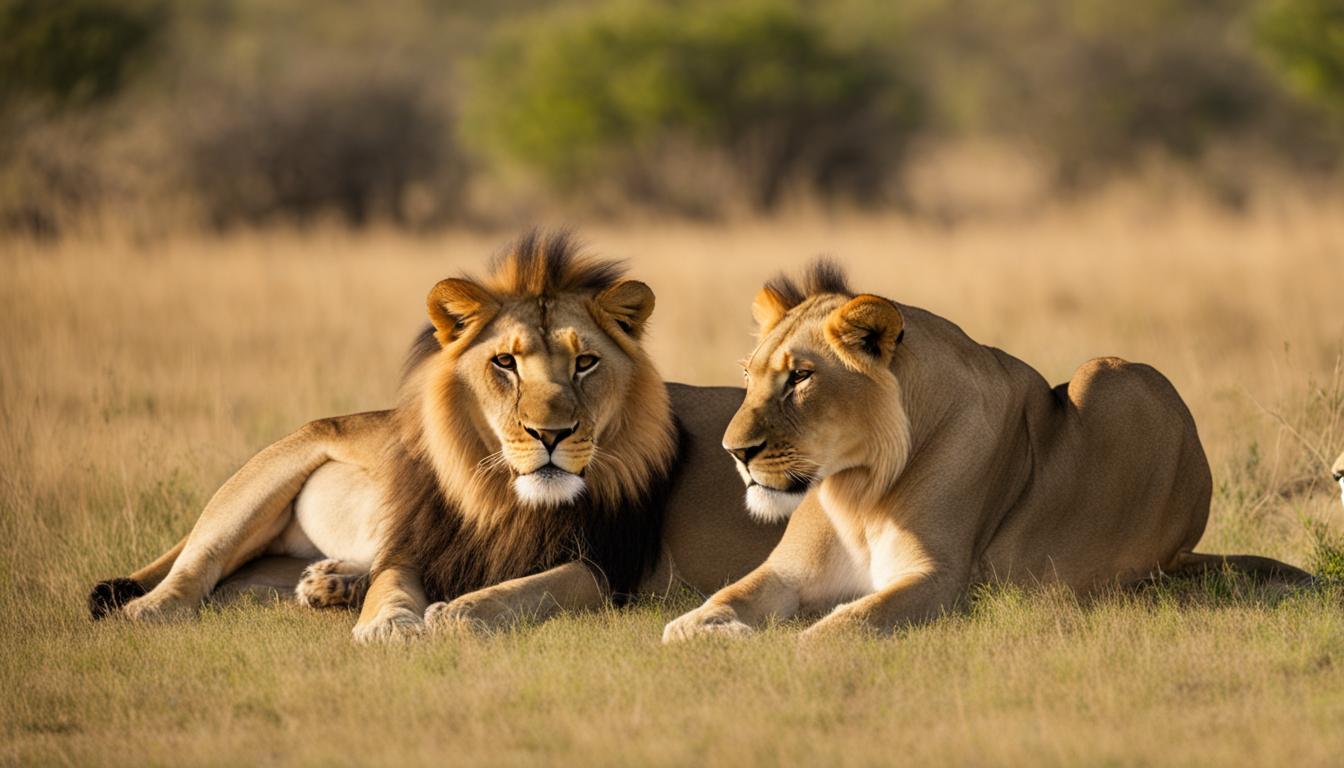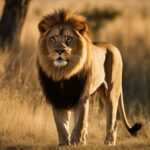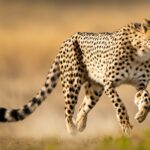Lions, known for their majestic appearance and powerful demeanor, have a fascinating social structure. They live in groups called prides, consisting of several related females, their cubs, and a small number of adult males. Lions form prides for efficient hunting, territorial protection, and the rearing of their young. Each member of the pride plays a crucial role in maintaining the group dynamics and ensuring its survival.
Key Takeaways:
- Lions have a complex social structure and live in prides.
- Prides consist of related females, their cubs, and a few adult males.
- Males defend the pride’s territory, while females focus on hunting and cub care.
- Cubs are essential for the continuity of the pride and learn from other pride members.
- Lion roars serve various purposes in social interactions and communication.
The Role of Male Lions in a Pride
Male lions play a crucial role in the social dynamics of a pride. They are responsible for defending the pride’s territory and ensuring the safety of the group and its resources. Their territorial behavior helps protect the pride from intruders and maintains a stable environment for the pride members. Male lions are known for their majestic appearance and powerful presence, which has earned them the title of “kings of the jungle”.
In addition to territorial defense, male lions also contribute to the genetic diversity of the pride by fathering cubs. They engage in mating rituals and form alliances with other males to increase their chances of successful mating. By fathering cubs, male lions help to ensure a healthy and sustainable population within the pride.
The role of male lions in a pride is vital for the overall survival and success of the group. Their strength and protective instincts contribute to the unity and stability of the pride, allowing the females to focus on hunting and raising the cubs. Together, the male and female lions form a cooperative and balanced social structure that is essential for their survival in the wild.
The Role of Male Lions in a Pride
| Role | Responsibilities |
|---|---|
| Territorial Defense | Protecting the pride’s territory from intruders |
| Genetic Diversity | Fathering cubs to maintain genetic variation within the pride |
| Cooperation | Working together with females in a balanced social structure |
The Role of Female Lions in a Pride
In a lion pride, the female lions, also known as lionesses, play a vital role in the social structure and functioning of the group. They are responsible for hunting and providing food for the pride, ensuring the survival and well-being of their members.
The lionesses work together in coordinated hunts, using strategic hunting techniques to take down large prey. They exhibit exceptional teamwork and communication, allowing them to successfully bring down animals much larger than themselves. This cooperative hunting behavior maximizes their efficiency and increases their chances of a successful kill.
Furthermore, lionesses are not only skilled hunters but also dedicated mothers and caretakers. They care for the cubs, teaching them essential survival skills and guiding their development. The bond between lionesses in a pride is strong, and they support each other in raising the young and defending the pride from threats. This teamwork and collaboration are essential for the survival and success of the pride.
Lioness Hunting Strategies
Lionesses employ various hunting strategies to increase their hunting success. One common technique is the ambush method, where they silently approach their prey and launch a surprise attack. Another strategy is the encircling method, where lionesses surround their prey, preventing escape and ensuring a successful kill. These hunting strategies are carefully coordinated, with each lioness understanding her role and contributing to the overall success of the hunt.
Table: Lioness Hunting Strategies
| Strategy | Description |
|---|---|
| Ambush | Silently approaching prey and launching a surprise attack |
| Encircling | Surrounding prey to prevent escape and ensure a successful kill |
| Coordinated Chase | Working together to outmaneuver and exhaust prey |
| Collaborative Hunting | Coordinating efforts with other lionesses for a shared kill |
Lionesses’ skills, teamwork, and dedication to their pride make them vital contributors to the social structure and functioning of a lion pride. They exhibit remarkable hunting strategies, care for their cubs, and support each other in the collective effort of survival and prosperity.
The Importance of Cubs in a Pride
Cubs play a crucial role in the continuity and strength of a lion pride. They are not only the future leaders but also contribute to the cooperative behavior and social structure of the pride.
Lion cubs are extensively cared for by the lionesses, who play a significant role in their upbringing and education. They teach the cubs essential survival skills, such as hunting techniques and social behaviors. Through their guidance, the lionesses ensure that the young ones are well-equipped to thrive in the harsh savannah environment.
Cooperation among the lion cubs is vital for their development and the overall success of the pride. They learn to interact and communicate with each other, establishing bonds that will strengthen the unity of the pride in the future. The cubs engage in playful activities, honing their physical abilities and building the foundation of their social relationships.
| Key Role of Lion Cubs in a Pride | Benefits for the Pride |
|---|---|
| Educating and learning from each other | Promotes cooperative behavior and social learning among pride members. |
| Building social bonds | Strengthens unity and cooperation within the pride. |
| Continuity of the pride | Ensures the survival and future of the pride. |
The survival of lion cubs is crucial for the long-term success of the pride. As they grow, they will assume essential roles in hunting, defending the territory, and contributing to the overall well-being of the pride. Protecting and nurturing the cubs is vital to maintaining a healthy lion population and preserving the intricate family dynamics within prides.
The Significance of Lion Roars in Social Interactions
Lion roars play a crucial role in the social interactions of these majestic creatures. They serve as a form of communication that helps lions establish and defend their territories, coordinate actions, and reunite separated members of their pride. Additionally, lion roars can attract the attention of nearby lionesses in estrus, signaling their presence and availability as potential mates. Moreover, roaring serves as a way for male lions to assert dominance among other males.
When lions roar, their vocalizations can be heard over long distances, allowing them to communicate with other pride members during hunts or territorial disputes. This communication helps to maintain cohesion within the pride and coordinate hunting strategies. By roaring, lions can alert their pride members about the presence of prey, ensuring efficient and successful hunts.
“The roar of a lion is the embodiment of strength and power in the animal kingdom.” – Wildlife expert
Lions have a unique vocal structure that enables them to produce loud and resonant roars. These roars are often used as a display of strength and dominance, serving as a warning to rival males or potential intruders. The deep, low-frequency sound of a lion’s roar can convey information about the size and health of the individual, making it an effective means of asserting dominance in the animal kingdom.
Roaring is not only a means of communication but also a defining characteristic of the lion’s identity. It symbolizes their presence, their unity as a pride, and their role as the kings of the jungle. Understanding the significance of lion roars enhances our knowledge of their social interactions and hunting strategies, allowing us to appreciate these magnificent creatures on a deeper level.
| Significance of Lion Roars | Examples |
|---|---|
| Establishing and Defending Territories | Lions use their roars to mark their territory and warn potential intruders. |
| Coordination During Hunts | Roaring helps lions communicate with each other during hunts, improving hunting efficiency. |
| Reuniting Separated Members | Lion roars can be used to locate and reunite separated members of a pride. |
| Attracting Potential Mates | The powerful roars of male lions can attract the attention of nearby lionesses in estrus. |
| Asserting Dominance | Lion roars serve as displays of strength and dominance among other males. |
Lion Social Behavior in the Wild and Conservation Efforts
Lions are not only fascinating creatures with complex social structures but also a species in need of conservation efforts. Understanding lion social behavior is crucial for ensuring their survival in the wild. In addition to their intricate communication through vocalizations, lions exhibit various care and behaviors that contribute to their well-being and the preservation of their populations.
Conservation centers play a vital role in protecting lions and studying their vocalizations. These vocalizations provide valuable insights into their health, emotions, and behavior. By listening to and interpreting their roars, growls, and other vocal signals, researchers and conservationists can assess the overall well-being of individual lions and tailor their care accordingly.
Conservation efforts for lions extend beyond vocalizations. Preserving their habitats is of utmost importance to maintain their populations in the wild. Lions are apex predators and play a crucial role in the ecosystem. Protecting their territories and ensuring access to prey are essential for their survival. Conservation organizations focus on raising awareness about the significance of lions in the ecosystem, educating the public, and advocating for sustainable practices that benefit both lions and their habitats.
| Conservation Efforts | Benefits |
|---|---|
| Promoting habitat preservation | Ensures suitable environments for lion populations |
| Anti-poaching initiatives | Reduces illegal hunting and protects lions from harm |
| Community-based conservation programs | Engages local communities in lion conservation and provides alternative livelihoods |
| Education and awareness campaigns | Increases public understanding of lion conservation and fosters support |
Conclusion
Lions are not only regal creatures but also vital components of our natural world. Their social behavior, vocalizations, and care practices offer valuable insights into their well-being and conservation needs. Through concerted conservation efforts and public awareness, we can protect their habitats, preserve their populations in the wild, and ensure a future where lions continue to roam the savannas, representing the epitome of strength and majesty.
Conclusion
Lions are truly remarkable creatures with fascinating social behavior. The pride, consisting of related females, their cubs, and a few adult males, serves as a strong unit for hunting, territorial protection, and cub rearing. Male lions play a crucial role in defending the pride’s territory, while female lions excel in hunting and caring for the young.
Communication is key to the social interactions of lions, with roaring playing a vital role. Roars serve as a means of establishing and defending territories, coordinating actions during hunts, and announcing availability to potential mates. These vocalizations also provide insights into the health and well-being of lions in conservation centers.
Conservation efforts are essential in preserving the social behavior and overall survival of lions. Protecting their habitats and raising awareness about their significance in the ecosystem are crucial steps. By focusing on lion social behavior, communication, and conservation, we can contribute to the long-term preservation of these majestic creatures.
Do Cheetahs Have a Similar Social Structure as Lions?
Do Cheetahs Have a Similar Social Structure as Lions? When it comes to social structure, cheetahs chirping: the mystery demystified. Unlike lions, cheetahs are solitary animals that prefer to roam and hunt on their own. While they may form small groups of family members, they don’t possess the hierarchical pride structure seen in lions. Cheetahs rely on their own skills and agility to survive, making their social dynamics quite distinct from their roaring counterparts.
FAQ
How do lions interact socially within their prides and beyond?
Lions have a complex social structure and live in groups called prides. They interact within the pride for hunting efficiency, territorial protection, and the rearing of cubs.
What is the role of male lions in a pride?
Male lions defend the pride’s territory, ensuring the safety of the pride and its resources. They father cubs and play a crucial role in maintaining the genetic diversity of the pride.
What is the role of female lions in a pride?
Female lions are responsible for hunting and providing food for the pride. They also care for the cubs, teaching them essential survival skills.
What is the importance of cubs in a pride?
Cubs are the future of the pride and are extensively cared for by the lionesses. They learn essential skills from their mothers and other members of the pride.
What is the significance of lion roars in social interactions?
Lion roars serve multiple important purposes in social interactions, including establishing and defending territories, coordinating actions, and asserting dominance.
What is the relationship between lion social behavior and conservation efforts?
Lion social behavior has implications for conservation efforts, as vocalizations can provide insights into their behavior and help tailor their care in conservation centers. Conservation efforts aim to protect lion habitats and raise awareness about their significance in the ecosystem.







